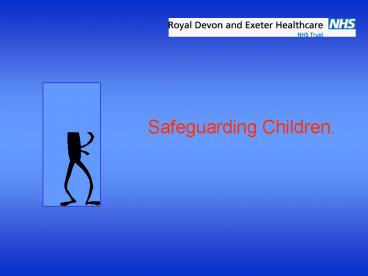Safeguarding Children. - PowerPoint PPT Presentation
Title:
Safeguarding Children.
Description:
... inflicting harm or failing to act to prevent harm. ... Protecting children is everybody s business. Your information however small may be the key. – PowerPoint PPT presentation
Number of Views:251
Avg rating:3.0/5.0
Title: Safeguarding Children.
1
Safeguarding Children.
2
What has this to do with me?
- Protecting children is everyones responsibility
- If you aware of anything that may impair an
adults ability to care for a child e.g substance
or alcohol misuse, physical or mental illness,
then you have a duty of care to the child even
when the child is not your patient.
3
Where can I get advice?
- From your line manager or from the Trust named
child protection professionals - xxxx - xxxx
- Nurse Consultant Safeguarding Children
- xxxx - xxxx
- Consultant Paediatrician
- xxxx xxxx
- Senior Midwife
4
Child protection in England
- 26,400 children are on the child protection
register (2006) - Each week 3 children die following abuse and
neglect - Homicide rates for under 1 year are 5 times
greater than the average - 80 of child homicides are carried out by a
parent and 10 by a stranger
5
A Child is
- a person under the age of eighteen
- (Children Act 1989)
6
What is abuse?
- A person may abuse or neglect a child by
- inflicting harm
- or failing to act to prevent harm.
- Children may be abused in
- a family
- an institutional or community setting
- By those known to them or, more rarely, by a
stranger. - Working Together to Safeguard children 2006
7
Physical Abuse
May involve Hitting, Shaking, throwing,
poisoning, burning or scalding, drowning,
suffocating or otherwise causing physical harm to
the child. Fabricated or Induced Illness by
Proxy Parent or carer feigns symptoms of, or
deliberately causes ill health in
child. Working Together to Safeguard Children
DOH 2006
8
Sexual Abuse
Involves forcing or enticing a child to take part
in sexual activities, including prostitution,
whether or not the child is aware of what is
happening. Physical contact - penetrative or
non-penetrative Non-contact activities -
involving children in looking at, or in the
production of, sexual online images, watching
sexual activities or encouraging children to
behave in sexually inappropriate ways. Working
Together to safeguard children, DOH 2006
9
Emotional Abuse
The persistent emotional ill-treatment of a child
such as to cause severe and persistent adverse
effects on the childs emotional development.
- Worthless or unloved inadequate or valued only
in so far as they meet the needs of another
person - May feature age or developmentally inappropriate
expectations being imposed on children. - May involve seeing or hearing the ill-treatment
of another or involve serious bullying or
causing children frequently to feel frightened
or in danger, or the exploitation or corruption
of children. - Some level involved in all types of
ill-treatment but may occur alone. - Working Together to Safeguard Children DOH
2006
10
Domestic Violence
- Every week in the UK two women are killed by
current or former partners. - Domestic violence accounts for one quarter of all
violent crime. - 1 in 4 women aged 16-59 1 in 7 men have been
physically assaulted by a current or former
partner. - Domestic violence often starts or intensifies
during pregnancy. - Domestic Violence Resource Pack DOH 2000
11
Neglect
The persistent failure to meet a childs basic
physical and/or psychological needs, likely to
result in the serious impairment of the childs
health or development.
- May involve a parent or carer failing to
- provide adequate food, shelter and clothing
(including exclusion from home or
abandonment) - protect a child from physical and emotional harm
or danger - ensure adequate supervision (including use of
inadequate caregivers) - ensure access to appropriate medical treatment
- It can also include neglect of, or
unresponsiveness to, a childs basic emotional
needs - Working Together to Safeguard Children, 2006
12
Immediate Action to safeguard a child
- Share
- your suspicions with your line manager or the
Trust named child protection professionals - Refer
- to Children and Young People Services (social
services) so that the child is protected and the
family receive the help and support they need to
look after their child. Follow up in writing
within 48 hours. - Record
- your findings and actions taken. Where
appropriate draw a diagram of any injury. Dont
forget time, date and signature.
13
Child Abuse can happen anywhere.
- Cases of abuse have been found in poor and
affluent homes, in rural and urban settings, in
all religious groups and races. (Bennett
1990) - And by anyone
- Parents, relatives family members,
- Friends, neighbours and baby sitters,
- Clinical staff, paid care staff, volunteers and
associates.
14
Protecting children is everybodys business.
- Your information however small may be the key.
- Report it - Dont expect someone else to!!!































